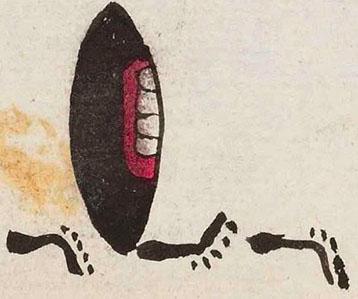Itztocan (Mdz42r)
This compound glyph for the place name Itztocan shows an upright obsidian (itztli) blade or knife that has a red mouth and four white teeth on the right side. Underneath the knife are three horizontal, alternating footprints that move along an invisible road (otli). the locative suffix (-can) is not shown visually.
Stephanie Wood
Alternating footprints show movement across the landscape, and can imply a road. Here, the "o" of otli (road) has a phonetic role in the middle of the place name, Itztocan. The stem for obsidian (itzt-) also seems to play a phonetic role. Together, the two sounds produce the word itztoc, which means "something visible." So, this place may have a great view or some other characteristic that led to this name.
Footprint glyphs have a wide range of translations. In this collection, so far, we can attest to yauh, xo, pano, -pan, paina, temo, nemi, quetza, otli, iyaquic hualiloti, huallauh, tetepotztoca, totoco, -tihui, and the vowel "o." Other research (Herrera et al, 2005, 64) points to additional terms, including: choloa, tlaloa, totoyoa, eco, aci, quiza, maxalihui, centlacxitl, and xocpalli.
Stephanie Wood
ytztucan. puo
Itztocan, pueblo
Stephanie Wood
c. 1541, but by 1553 at the latest
Stephanie Wood
obsidian blades, flint knife, flint knives, roads, paths, trails, nombres de lugares

itz(tli), obsidian blade, https://nahuatl.wired-humanities.org/content/itztli
o(tli), road, path, trail, https://nahuatl.wired-humanities.org/content/otli
itztoc, something visible, https://nahuatl.wired-humanities.org/content/itztoc
-can (locative suffix), https://nahuatl.wired-humanities.org/content/can-0
-can (locative suffix), https://nahuatl.wired-humanities.org/content/can-2
El Lugar de la Buenavista(?)
Codex Mendoza, folio 42 recto, https://digital.bodleian.ox.ac.uk/objects/2fea788e-2aa2-4f08-b6d9-648c00..., image 94 of 188.
The Bodleian Libraries, University of Oxford, hold the original manuscript, the MS. Arch. Selden. A. 1. This image is published here under the UK Creative Commons, “Attribution-NonCommercial-ShareAlike 3.0 License” (CC-BY-NC-SA 3.0).


